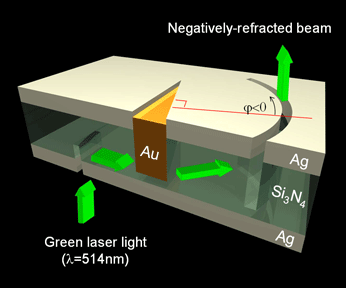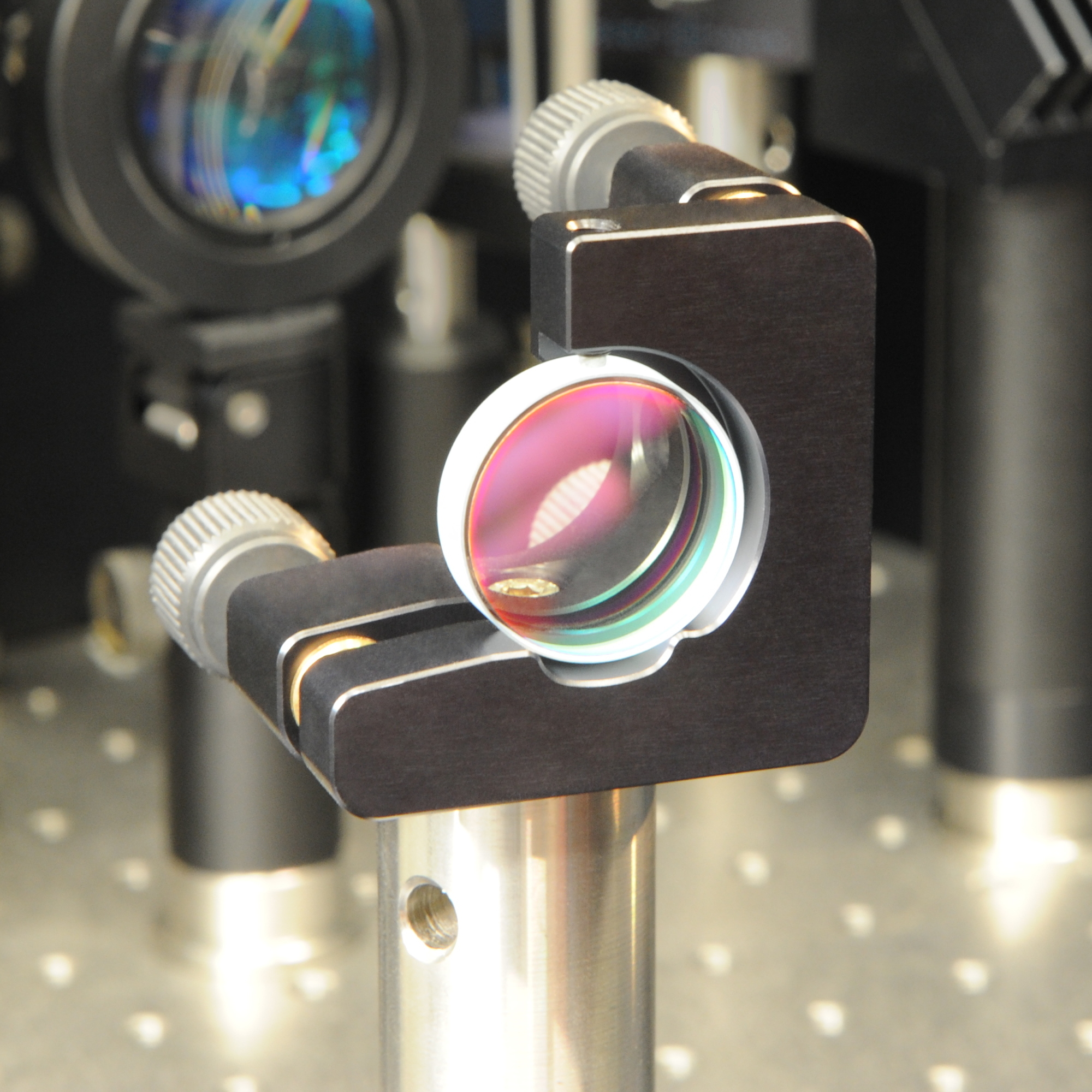|
Plasmonics
Plasmonics or nanoplasmonics refers to the generation, detection, and manipulation of signals at optical frequencies along metal-dielectric interfaces in the nanometer scale. Inspired by photonics, plasmonics follows the trend of miniaturizing optical devices (see also nanophotonics), and finds applications in sensing, microscopy, optical communications, and bio-photonics. Principles Plasmonics typically utilizes so-called surface plasmon polaritons (SPPs), that are coherent electron oscillations travelling together with an electromagnetic wave along the interface between a dielectric (e.g. glass, air) and a metal (e.g. silver, gold). The SPP modes are strongly confined to their supporting interface, giving rise to strong light-matter interactions. In particular, the electron gas in the metal oscillates with the electro-magnetic wave. Because the moving electrons are scattered, ohmic losses in plasmonic signals are generally large, which limits the signal transfer distances to ... [...More Info...] [...Related Items...] OR: [Wikipedia] [Google] [Baidu] |
Plasmonic Waveguide Device Visible Freq
In physics, a plasmon is a quantum of plasma oscillation. Just as light (an optical oscillation) consists of photons, the plasma oscillation consists of plasmons. The plasmon can be considered as a quasiparticle since it arises from the quantization of plasma oscillations, just like phonons are quantizations of mechanical vibrations. Thus, plasmons are collective (a discrete number) oscillations of the free electron gas density. For example, at optical frequencies, plasmons can couple with a photon to create another quasiparticle called a plasmon polariton. Derivation The plasmon was initially proposed in 1952 by David Pines and David Bohm and was shown to arise from a Hamiltonian for the long-range electron-electron correlations. Since plasmons are the quantization of classical plasma oscillations, most of their properties can be derived directly from Maxwell's equations. Explanation Plasmons can be described in the classical picture as an oscillation of electron den ... [...More Info...] [...Related Items...] OR: [Wikipedia] [Google] [Baidu] |
Surface Plasmon Polariton
Surface plasmon polaritons (SPPs) are electromagnetic waves that travel along a metal– dielectric or metal–air interface, practically in the infrared or visible-frequency. The term "surface plasmon polariton" explains that the wave involves both charge motion in the metal ("surface plasmon") and electromagnetic waves in the air or dielectric (" polariton"). They are a type of surface wave, guided along the interface in much the same way that light can be guided by an optical fiber. SPPs have a shorter wavelength than light in vacuum at the same frequency (photons). Hence, SPPs can have a higher momentum and local field intensity. Perpendicular to the interface, they have subwavelength-scale confinement. An SPP will propagate along the interface until its energy is lost either to absorption in the metal or scattering into other directions (such as into free space). Application of SPPs enables subwavelength optics in microscopy and photolithography beyond the diffracti ... [...More Info...] [...Related Items...] OR: [Wikipedia] [Google] [Baidu] |
Localized Surface Plasmon
A localized surface plasmon (LSP) is the result of the confinement of a surface plasmon in a nanoparticle of size comparable to or smaller than the wavelength of light used to excite the plasmon. When a small spherical metallic nanoparticle is irradiated by light, the oscillating electric field causes the conduction electrons to oscillate coherently. When the electron cloud is displaced relative to its original position, a restoring force arises from Coulombic attraction between electrons and nuclei. This force causes the electron cloud to oscillate. The oscillation frequency is determined by the density of electrons, the effective electron mass, and the size and shape of the charge distribution. The LSP has two important effects: electric fields near the particle's surface are greatly enhanced and the particle's optical absorption has a maximum at the plasmon resonant frequency. Surface plasmon resonance can also be tuned based on the shape of the nanoparticle. The plasmon frequen ... [...More Info...] [...Related Items...] OR: [Wikipedia] [Google] [Baidu] |
Photonics
Photonics is a branch of optics that involves the application of generation, detection, and manipulation of light in form of photons through emission, transmission, modulation, signal processing, switching, amplification, and sensing. Though covering all light's technical applications over the whole spectrum, most photonic applications are in the range of visible and near-infrared light. The term photonics developed as an outgrowth of the first practical semiconductor light emitters invented in the early 1960s and optical fibers developed in the 1970s. History The word 'Photonics' is derived from the Greek word "phos" meaning light (which has genitive case "photos" and in compound words the root "photo-" is used); it appeared in the late 1960s to describe a research field whose goal was to use light to perform functions that traditionally fell within the typical domain of electronics, such as telecommunications, information processing, etc. Photonics as a field began with the ... [...More Info...] [...Related Items...] OR: [Wikipedia] [Google] [Baidu] |
Nanophotonics
Nanophotonics or nano-optics is the study of the behavior of light on the nanometer scale, and of the interaction of nanometer-scale objects with light. It is a branch of optics, optical engineering, electrical engineering, and nanotechnology. It often involves dielectric structures such as nanoantennas, or metallic components, which can transport and focus light via surface plasmon polaritons. The term "nano-optics", just like the term "optics", usually refers to situations involving ultraviolet, visible, and near-infrared light (free-space wavelengths from 300 to 1200 nanometers). Background Normal optical components, like lenses and microscopes, generally cannot normally focus light to nanometer (deep subwavelength) scales, because of the diffraction limit (Rayleigh criterion). Nevertheless, it is possible to squeeze light into a nanometer scale using other techniques like, for example, surface plasmons, localized surface plasmons around nanoscale metal objects, an ... [...More Info...] [...Related Items...] OR: [Wikipedia] [Google] [Baidu] |
Bragg Mirror
A dielectric mirror, also known as a Bragg mirror, is a type of mirror composed of multiple thin layers of dielectric material, typically deposited on a substrate of glass or some other optical material. By careful choice of the type and thickness of the dielectric layers, one can design an optical coating with specified reflectivity at different wavelengths of light. Dielectric mirrors are also used to produce ultra-high reflectivity mirrors: values of 99.999% or better over a narrow range of wavelengths can be produced using special techniques. Alternatively, they can be made to reflect a broad spectrum of light, such as the entire visible range or the spectrum of the Ti-sapphire laser. Mirrors of this type are very common in optics experiments, due to improved techniques that allow inexpensive manufacture of high-quality mirrors. Examples of their applications include laser cavity end mirrors, hot and cold mirrors, thin-film beamsplitters, high damage threshold mirrors, ... [...More Info...] [...Related Items...] OR: [Wikipedia] [Google] [Baidu] |
Optical Materials Express
''Optical Materials Express'' is a monthly peer-reviewed scientific journal published by The Optical Society. It covers advances in and applications of optical materials, including but not limited to nonlinear optical materials, laser media, nanomaterials, metamaterials and biomaterials. Its editor-in-chief is Andrea Alù ( City University of New York). The founding editor-in-chief was David J. Hagan. According to the ''Journal Citation Reports'', the journal has a 2021 impact factor The impact factor (IF) or journal impact factor (JIF) of an academic journal is a scientometric index calculated by Clarivate that reflects the yearly mean number of citations of articles published in the last two years in a given journal, as ... of 3.074. References External links * Optics journals Materials science journals English-language journals Monthly journals Publications established in 2011 Optica (society) academic journals {{engineering-journal-stub ... [...More Info...] [...Related Items...] OR: [Wikipedia] [Google] [Baidu] |
Graphene
Graphene () is an allotrope of carbon consisting of a single layer of atoms arranged in a hexagonal lattice nanostructure. "Carbon nanostructures for electromagnetic shielding applications", Mohammed Arif Poothanari, Sabu Thomas, et al., ''Industrial Applications of Nanomaterials'', 2019. "Carbon nanostructures include various low-dimensional allotropes of carbon including carbon black (CB), carbon fiber, carbon nanotubes (CNTs), fullerene, and graphene." The name is derived from "graphite" and the suffix -ene, reflecting the fact that the allotrope of carbon contains numerous double bonds. Each atom in a graphene sheet is connect ... [...More Info...] [...Related Items...] OR: [Wikipedia] [Google] [Baidu] |
Nanoscale (journal)
''Nanoscale'' is a peer-reviewed scientific journal covering experimental and theoretical research in all areas of nanotechnology and nanoscience. It is published by the Royal Society of Chemistry. According to the ''Journal Citation Reports'', the journal has a 2021 impact factor The impact factor (IF) or journal impact factor (JIF) of an academic journal is a scientometric index calculated by Clarivate that reflects the yearly mean number of citations of articles published in the last two years in a given journal, as ... of 8.307. References External links * Royal Society of Chemistry academic journals Biweekly journals Publications established in 2009 Nanotechnology journals English-language journals {{Science-journal-stub ... [...More Info...] [...Related Items...] OR: [Wikipedia] [Google] [Baidu] |
Wave Vector
In physics, a wave vector (or wavevector) is a vector used in describing a wave, with a typical unit being cycle per metre. It has a magnitude and direction. Its magnitude is the wavenumber of the wave (inversely proportional to the wavelength), and its direction is perpendicular to the wavefront. In isotropic media, this is also the direction of wave propagation. A closely related vector is the angular wave vector (or angular wavevector), with a typical unit being radian per metre. The wave vector and angular wave vector are related by a fixed constant of proportionality, 2π radians per cycle. It is common in several fields of physics to refer to the angular wave vector simply as the ''wave vector'', in contrast to, for example, crystallography. It is also common to use the symbol ''k'' for whichever is in use. In the context of special relativity, ''wave vector'' can refer to a four-vector, in which the (angular) wave vector and (angular) frequency are combined. Def ... [...More Info...] [...Related Items...] OR: [Wikipedia] [Google] [Baidu] |
Photonics (journal)
This is a list of academic journals published by MDPI. As of September 2022, MDPI publishes 399 peer-reviewed academic journals and nine conference journals. {, class="wikitable sortable" , +List of MDPI journals !Journal name !Subject !Established !Impact factor !Scopus ranking (2021) !ISSN , - , ''Acoustics'' , Engineering , 2019 , Impact factors are calculated on the previous two years. Impact factors for journals established in 2019 will not be available until 2022. , – , 2624-599X , - , ''Actuators'' , Engineering , 2012 , 2.062nd percentile, 2076-0825 , - , ''Administrative Sciences'' , Business , 2011 , 69th percentile, 2076-3387 , - , ''Adolescents'' , Health , 2021 , Impact factors are calculated on the previous two years. Impact factors for journals established in 2021 will not be available until 2024. , – , 2673-7051 , - , ''Advances in Respiratory Medicine'' (formerly ''Pneumonologia i Alergologia Polska)'' , Health , , 27th percentile, 2451-4934 , - ... [...More Info...] [...Related Items...] OR: [Wikipedia] [Google] [Baidu] |







